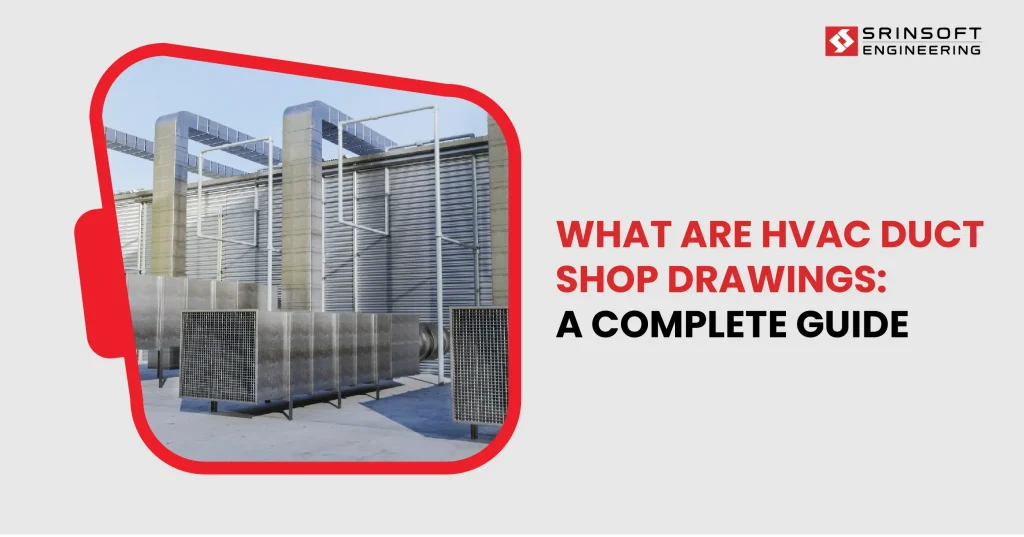
In construction, HVAC duct shop drawings services are significant since they help in organizing and executing HVAC system installation. These drawings serve as a communication tool for Architects, Engineers, HVAC Specialists, and Construction workers.
They give a ductwork installation plan that corresponds with the building’s design and results in the smooth incorporation of the HVAC system.
The function of HVAC shop drawings is to translate the conceptual design into the final design that can be used for manufacturing and installation of the HVAC system.
This resolves complexities that may occur and guarantees that all parts fit within a targeted structure and are optimized for operation.
What are HVAC Duct Shop Drawings?
HVAC Duct Shop Drawings provides several types of information required in project plans and specifications for the fabricating and installing contractor to provide the duct system performance intended by the system designer.
HVAC shop drawings are comprehensive duct layout drawings used for the design and installation of HVAC systems. They are graphic images generated by CAD program that show the HVAC layout as seen from above in the building.
These types of drawings are beneficial in distinct phases, from planning to construction and installation.
HVAC Shop Drawings Include:
1. Comprehensive duct layout specifying sizes, pressure class, design airflows & routing of the duct system.
2. The types of fittings to be used based on the designer’s calculations of fitting losses (i.e., square versus 45 degrees entry taps, conical versus straight taps, etc.).
3. Use of turning vanes or splitter vanes.
4. Location of access doors.
5. Location and type of control and balancing dampers.
6. Location and types of diffusers.
7. Requirements for duct insulation.
8. Location & types of fire protection devices – fire dampers, smoke dampers, combination fire/smoke dampers & ceiling dampers. Building codes require this information to be displayed on the design documents submitted for building permits.
Why Are HVAC Shop Drawings Important?
HVAC shop drawings ensure compliance with codes and standards and guide fabrication and installation process for efficient HVAC functioning.
Also includes Accurate fabrication, Assembly of equipment, Accurate installation of buildings HVAC components.
Resolves fabrication and installation challenges for multiples stakeholders.
Different Types of HVAC Shop Drawings
1. HVAC Drawings
Mechanical drawings or HVAC drawings depict the layout of heating, ventilation, and air conditioning systems within a building including details such as placement of heating and cooling equipment, ventilation strategies, and other specifications related to HVAC.
2. Coordination Drawings
They ensure coordination between multiple systems in a building. Coordination drawings are useful in avoiding clashes between water pipes, electrical pipes, drainage pipes, air ducts & other equipment.
3. As-Built Drawings
These drawings depict the final state of the HVAC system after construction. They show the changes and deviations made from the original HVAC design and HVAC drawings. They help in identifying any faults. As-built drawings are important for the client.
Services Included in HVAC Duct Shop Drawings
- HVAC Shop Drawings Services
- HVAC Duct Design
- Duct Sections and Level HVAC Duct Fabrication Drawing
- HVAC Duct Layout Drawing
- Details of Air Handling Unit
- Clash Detection & Resolution
- Mechanical Room BIM Modeling
- Fire Dampers, Grilles, Coils, and Fans Modeling
- Humidifiers and Dehumidifiers Modeling
Key Things to Consider in HVAC Duct Shop Drawings
Key Components of Duct Shop Drawings.
- Ductwork Dimensions
- Material Type
- Duct Location of Duct Accessories of Branch Points and Their Size,
- Support Placements, Various Duct Routing Details
- Duct Accessories, notarized by dimensions and flow indications to show final air direction.
- Type of duct materials, vibration isolators for the equipment shown in detail
- Heat load calculations approved before AC drawing approval
- Diffusers/Grilles schedule showing type, size, airflow, throw, NC levels, etc.
- Round duct shown for the areas where there is no ceiling
- VCDs are shown on all duct branches as per specification.
- All supply, return, fresh and extract air duct sizes and airflows are shown on layout.
- Thermostat locations are shown for all AHUs, FCUs and VAVs13Drain valve & Access door shown for KED at the lowest point (Before the riser)
- Condensate drain provision is shown for AHUs, FCUs, FAHU with Drain pump interlink with thermostat15Check whether all FCUs and piping are no crossing the DB, SMDBs
- CHW valve Package, access platform shown for FCU &accessible for operation.
- All chilled water pipe sizes & Flow rate are shown in the layout.
- Verify pipe sizes with approved unit selection.
- Chilled water piping shall be provided with vapor barrier.
- Schedule for all the Equipment & components shown in the drwg as per approved HAP
Best Software for Creating HVAC System Diagrams
1. AutoCAD:
A mainstay of the industry known as AutoCAD assists in creating detailed drawings of 2D & 3D designs. Such a crucial feature makes it a powerful tool for sharing information, as it is available anywhere and for all users across different entities.
2. Revit:
Influenced by its advanced BIM (Building Information Modeling) features, Revit allows you to do complete modeling of your HVAC systems, thus helping you integrate better with other building systems.
3. SolidWorks:
SolidWorks offers specific design-and-analysis tools for HVAC systems with primary goal of performance and compliance, primarily based on 3D solid modeling.
4. MagiCAD:
Specially made for MEP (Mechanical, Electrical & Plumbing) design, MagiCAD automates complex algorithms required in HVAC systems & in this way, the design process can be redone in much faster time.
Each of these tools possesses specific distinct characteristics and functions, and the choice between them largely depends on the requirements of the project, the favorite selection of the design team, and compatibility with the work procedures of the other professionals working on its construction Specialized Tools for Fabrication of the ductwork drawing.
Best Practices for HVAC Drawings
1. Following Industry Standards
Stick to Guidelines Follow Industry Rules: Use guidelines like ASHRAE, SMACNA, and local regulations to make sure you’re in line with requirements and stay consistent.
Use Common Symbols: Go with standard symbols for HVAC parts to keep things clear and avoid mix-ups.
2. Clear and Detailed Layout
Scale and Accuracy: Use an appropriate scale and ensure that all components are accurately placed. This helps in precise installation and reduces errors.
Legible Annotations: Clearly label all components, including equipment, ducts, and connections. Use readable fonts and sizes.
Dimensioning: Provide precise dimensions for all components, including duct sizes, equipment locations, and clearances.
3. Comprehensive Information
System Diagrams: Include detailed diagrams of HVAC systems, such as ductwork layouts, piping systems, and equipment placement.
Schedules: Provide equipment schedules, including specifications, quantities, and locations.
Sequence of Operations: Outline the sequence of operations for controls and systems to clarify how different parts of the system interact.
4. Integration with Other Systems
Coordination: Ensure HVAC drawings are coordinated with architectural, structural, and electrical drawings to avoid conflicts and ensure smooth integration.
Conflict Detection: Use Building Information Modeling (BIM) or similar tools to detect and resolve potential conflicts between different systems before construction begins
5. Accuracy and Precision
Detailed Specifications: Include precise dimensions, duct layouts, equipment specifications, pipe routing, and electrical connections to ensure accurate onsite execution.
Avoid Guesswork: Eliminate the need for redesign or rework by providing detailed and precise specifications.
6. Streamlined Installation
Visual Roadmap: Provide a visual roadmap to contractors and fabricators, enabling them to work with confidence and surety
Seamless Integration: Ensure seamless integration with other systems like electrical, plumbing, and mechanical to avoid clashes or defects
7. Collaboration and Coordination
Effective Collaboration: Develop effective collaboration between the design team and other trades involved in the project to ensure drawing accuracy and precision1.
Regular Updates: Keep the drawings updated with any changes or modifications to the project to ensure everyone is on the same page.
How Can We Help?
HVAC Shop Drawings recognizes the importance of precise HVAC shop drawings and ductwork layout design in construction projects. We provide a comprehensive array of digital HVAC design solutions to assist you in producing detailed and accurate shop drawings.
Our skilled engineers & draftsmen use the latest technologies & software to develop HVAC shop drawings which align with your project needs & specifications.
Reach out to us today to discover more about our HVAC shop drawing services for both commercial and residential projects and find out how we can support you with your upcoming project.


